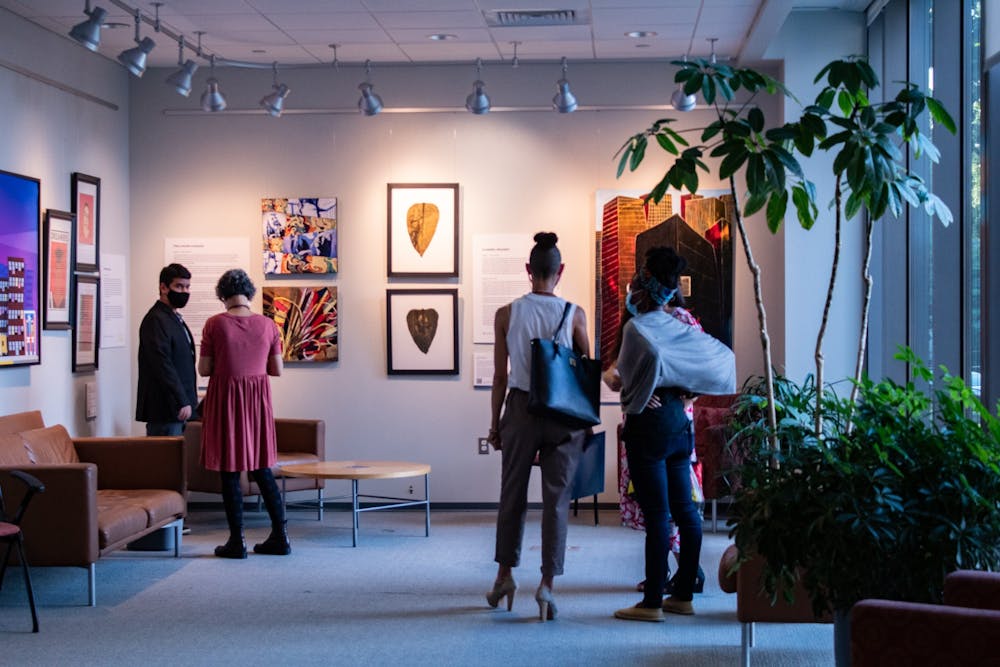Le Chevallier said he has a multicultural heritage: his mom is from Puerto Rico and his dad is from France. He was born in France, grew up in Puerto Rico and is now based in Garner. Le Chevallier said that being Latinx helps him understand immigrants who migrate to give their families a better future.
“Being Latino inspires me to understand people," Le Chevallier said. "One thing about Latinos is that literally all countries in Latin America, even though they're different countries, are very united. We share the same history, we have the same cultural icons, even though there's a lot of differences, I think we have more similarities than differences.”
Peter Marín
Marín was born and raised in Mexico City and is now based in Raleigh.
Marín said that he had a cultural upbringing that dealt with modernity, modern architecture and modern art. His work reflects the visions of Mexico as a modern country, he said.
“I was raised by a father who is an architect, a Mexican architect,” Marín said. “And so the inculcation into traditions, into folklore, into the painting tradition and other arts as they relate to Mexico were something that my dad is responsible for. And so being a painter is a direct result of having been exposed to all these different artistic traditions of Mexico.”
Antonio Alanís
Alanís is a Mexican-American artist based in Durham. Alanís graduated from UNC in 2013.
Alanís said he is interested in using his art to tell a story and expand on what it means to be a Latinx person in the South, incorporating themes of identity, home and belonging.
“What I've noticed is that the media oftentimes will sway the public to determine someone's personality or upbringing based on what, you know, some misconstrued or misinformed ways of who we are as Latinos or Latinx, Hispanic people,” Alanís said. “And I want this experience to inspire other people as well too, regardless of where they are identity-wise, to feel that they have the agency of saying who they are and correcting misinformation, fighting for the truth.”
Adriana Ameigh
Ameigh is a Puerto Rican abstract artist based in Raleigh. She works primarily with acrylics and oils with cold wax. The series she is currently working on focuses on exploring heritage and what it means to be a part of a diaspora.
To get the day's news and headlines in your inbox each morning, sign up for our email newsletters.
“Letters to the Homeland 3" (2021) is one of her pieces showcased in the exhibition and represents for her a time where she had to make a decision, she said.
“When you move somewhere different than where you're from, you come to an intersection where you're neither from there nor the other place," Ameigh said. “You're kind of somewhere in the middle of the two."
She said being in that position offers a unique perspective on belonging.
"You're incorporating things from where you grew up, as well as places from the new place you're in, if you've been there long enough," she said. "And if you try to move back, you've been gone too long. And if you stay where you are, you'll never be anything other than somebody that moves there from somewhere else. It's just what happens."
Ameigh said that she hopes this exhibit will provide role models for younger Latinx artists.
Gabriela Costas
Costas is an abstract painter from Orán, Salta, in northern Argentina who is now based in Winston-Salem. She mainly works with acrylic, crayons, watercolor pencils and gesso — a white paint mixed with binder-like chalk.
“It's a distinguished opportunity to share the element and expression of my journey from Argentina to North Carolina,” Costas said.
Costas' work focuses on nature, and she said she noticed similar biodiversity between her home in Argentina and North Carolina.
“For Argentina, it's a country of great scenic diversity from glaciers in the south, to the tropic in the north,” Costas said. “So there is a lot of contrast. And I found similar diversity in North Carolina."
Alexandre Emmanuel
Emmanuel is an artist from Olinda, Pernambuco in Brazil, now based in Raleigh. Emmanuel works with oil on canvas and uses spatulas, spoons and even fingers to create the pieces.
“In my work in general, I do describe it as a new impressionism, and this new impressionism is because it's very fast, the way I work... I have to start it and finish, sometimes in a couple of hours," Emmanuel said. "Because I am afraid that enthusiasm of that great moment goes down."
Exhibition impact
As a whole, Le Chevallier said that the exhibition showcases Latin American artists in a way that combats stereotypes.
“I think it's really important to change that narrative,” Le Chevallier said. “And to put them in a good light. Latino immigrants are really hard-working, and they come here and they take on a lot of jobs and they do positive thing for our communities, and they're not rewarded like they should.”
The "Being and Belonging: Perspectives in North Carolina" exhibit highlights Latinx voices in the community, Ameigh said. She said that each artist brings with them stories that are completely tied and interlaced with their history and heritage.
“We are part of what's here in North Carolina,” Ameigh said.
university@dailytarheel.com | elevate@dailytarheel.com




